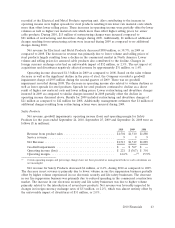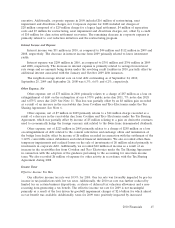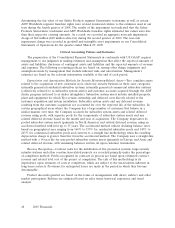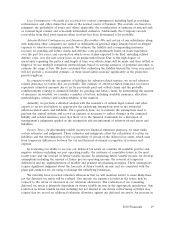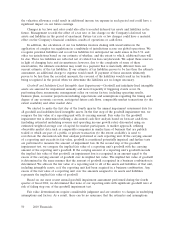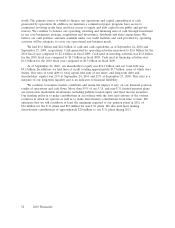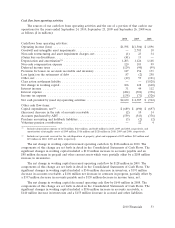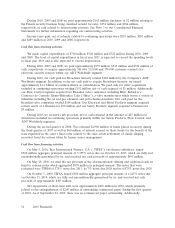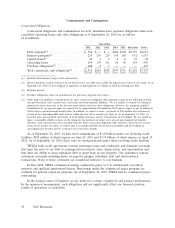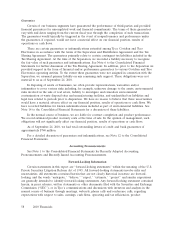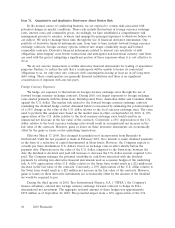ADT 2010 Annual Report Download - page 139
Download and view the complete annual report
Please find page 139 of the 2010 ADT annual report below. You can navigate through the pages in the report by either clicking on the pages listed below, or by using the keyword search tool below to find specific information within the annual report.made for purposes of the annual goodwill impairment test will prove to be accurate predictions of the
future. Examples of events or circumstances that could reasonably be expected to negatively affect the
underlying key assumptions and ultimately impact the estimated fair value of the aforementioned
reporting units may include such items as follows:
• A prolonged downturn in the business environment in which the reporting units operate (i.e.
sales volumes and prices) especially in the commercial construction and retailer end markets;
• An economic recovery that significantly differs from our assumptions in timing or degree;
• Volatility in equity and debt markets resulting in higher discount rates; and
• Unexpected regulatory changes.
While historical performance and current expectations have resulted in fair values of goodwill in
excess of carrying values, if our assumptions are not realized, it is possible that in the future an
impairment charge may need to be recorded. However, it is not possible at this time to determine if an
impairment charge would result or if such a charge would be material.
Long-Lived Assets—Asset groups held and used by the Company, including property, plant and
equipment and amortizable intangible assets, are reviewed for impairment whenever events or changes
in business circumstances indicate that the carrying amount of the asset group may not be fully
recoverable. Tyco performs undiscounted operating cash flow analyses to determine if impairment
exists. For purposes of recognition and measurement of an impairment for assets held for use, Tyco
groups assets and liabilities at the lowest level for which cash flows are separately identified. If an
impairment is determined to exist, any related impairment loss is calculated based on fair value.
Impairments to long-lived assets to be disposed of are recorded based upon the fair value less cost to
sell of the applicable assets. The calculation of the fair value of long-lived assets is based on
assumptions concerning the amount and timing of estimated future cash flows and assumed discount
rates, reflecting varying degrees of perceived risk. Since judgment is involved in determining the fair
value and useful lives of long-lived assets, there is a risk that the carrying value of our long-lived assets
may be overstated or understated.
Pension and Postretirement Benefits—Our pension expense and obligations are developed from
actuarial valuations. Two critical assumptions in determining pension expense and obligations are the
discount rate and expected long-term return on plan assets. We evaluate these assumptions at least
annually. Other assumptions reflect demographic factors such as retirement, mortality and turnover and
are evaluated periodically and updated to reflect our actual experience. Actual results may differ from
actuarial assumptions resulting in actuarial gains and losses. For active plans, such actuarial gains and
losses will be amortized over the average expected service period of the participants and in the case of
inactive plans over the average remaining life expectancy of participants. The discount rate represents
the market rate for high-quality fixed income investments and is used to calculate the present value of
the expected future cash flows for benefit obligations under our pension plans. A decrease in the
discount rate increases the present value of pension benefit obligations. A 25 basis point decrease in
the discount rate would increase the present value of pension obligations by approximately $89 million
and increase our annual pension expense by approximately $7 million. We consider the relative
weighting of plan assets by class, historical performance of asset classes over long-term periods, asset
class performance expectations as well as current and future economic conditions in determining the
expected long-term return on plan assets. A 50 basis point decrease in the expected long-term return
on plan assets would increase our annual pension expense by approximately $8 million.
Liquidity and Capital Resources
A fundamental objective of the Company is to have sufficient liquidity, balance sheet strength, and
financial flexibility to fund the operating and capital requirements of its core businesses around the
2010 Financials 51




